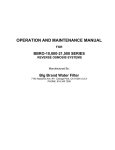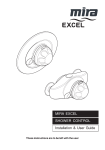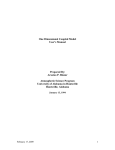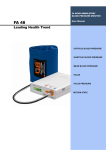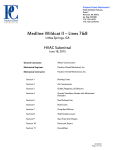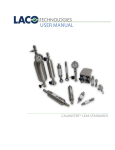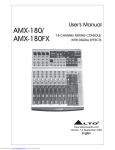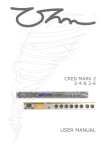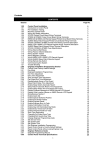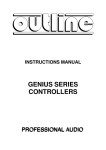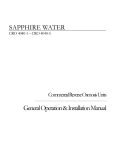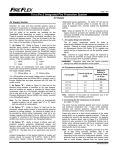Download R&D Series 150 Manual
Transcript
R & D SPECIALTIES R & D SPECIALTIES SERIES 150 RO CONTROLLER USER’S MANUAL © 2001-2010, by R & D Specialties, Inc. All Rights Reserved. No part of this document may be copied or reproduced in any form or by any means without the prior written permission of R & D Specialties. R & D Specialties makes no warranties with respect to this documentation. Information in this document is subject to change without notice. R & D Specialties shall not be held liable for technical or editorial errors or omissions that may appear in this document; nor for incidental or consequential damages resulting from the furnishing, performance, or use of this document. Document: Series 150 Released: June 2012 R & D Specialties 9918 W. I-20 Midland, Texas USA 79706 432 561-5707 Fax 432 561-5696 www.rdspec.com E-mail [email protected] i LIMITED WARRANTY R & D Specialties warrants to the original purchaser that the products it manufactures will be free from defects in material and workmanship for a period of twelve months from the date of shipment on parts and ninety days on labor. Some non R & D Specialties manufactured resale items may have warranty periods less than twelve months. R & D Specialties obligation under this warranty is limited exclusively to the repair or replacement of any product that R & D Specialties finds to be defective. Items returned for warranty consideration must have a return authorization number and be properly packaged, shipped prepaid and insured. This warranty is valid only when the products are properly installed, maintained and used for the purpose for which they were designed. Misuse, neglect, damage, accident, improper repair, or modification not authorized in writing by R & D Specialties will void this warranty. There are no warranties, expressed or implied, including the implied warranties for merchantability or fitness for a particular purpose that extend beyond the limited warranty expressly stated above. R & D Specialties liability to any purchaser of its products, whether in contract or in tort, and whether arising out of warranties, representations, instructions, installations, or defects from any cause, will be limited exclusively to repairing or replacing the product or any part thereof under the conditions set out above. ii TABLE OF CONTENTS INTRODUCTION 1 SPECIFICATIONS 1 FRONT PANEL CONTROLS AND INDICATORS 3 INSTALLATION Physical Installation Terminal Strip, Jumper and Adjustment Locations Power Wiring Pump and Valve Relay Outputs RO Pump Wiring Inlet and Flush Valve Wiring TDS / Conductivity Cell Wiring Switch Inputs Pressure Fault Switch Pretreat Switch Tank Full Switch I/O Expander Board Auxiliary Pump Boost Pump Divert Output Alarm Output Tank Low Switch 5 5 5 5 5 5 6 6 6 7 7 7 7 8 8 8 8 8 SETPOINTS Standard Setpoints Displaying or Changing Setpoints 12 14 SYSTEM OPERATION General Operation Display Operating Status Messages TDS / Conductivity Operating Hours Temperature 15 15 15 15 16 16 iii Warning Messages Tank Full Operation Tank Full Restart Tank Full Override Pressure Fault Auto Reset Alarm Silence Pretreat Membrane Flush Flush Mode High TDS / Conductivity Warning/Alarm Operating Hours Exceeded I/O Expander Auxiliary Output Tank Low Boost Pump Divert Output Alarm Output 16 16 16 17 17 17 17 17 18 19 19 19 19 19 20 20 20 20 ADJUSTMENTS TDS / Conductivity Calibration Display Adjustment 21 21 TROUBLESHOOTING System Inoperative Display Blank Inlet Valve Will Not Operate RO Pump Will Not Operate Unit Not Flushing or Not Flushing Correctly No or Incorrect TDS / Conductivity Reading 22 22 22 22 22 23 TDS / CONDUCTIVITY EXPANDER Installation / Wiring Setpoints Operation Calibration 24 25 25 25 iv FIGURES AND TABLES Figure 1 - Front Panel Controls and Indicators 3 Figure 2 - Terminal Strip, Jumper Locations Figure 3 - Sample Wiring Figure 4 - Expander Board Terminal Strip, Jumper Locations Figure 5 - TDS / Conductivity Cell Installation Figure 6 - TDS / Conductivity Expander 9 10 11 11 24 Table 1 - Switch Select Programming Table 2 - Expander Mode Programming Table 3 - Flush Type Table 4 - Flush Mode 6 8 18 19 v INTRODUCTION The R & D Specialties Series 150 controller is a state of the art control system for commercial and industrial reverse osmosis systems. The Series 150 combines features that have not previously been available in one compact unit. The Series 150 is a microprocessor controlled system that can monitor pressure and level switches. A TDS / Conductivity monitor/controller with programmable Setpoints is an integral part of the Series 150. The Series 150 displays system status and sensor and switch input status on an easy to read backlit display. User programmable Setpoints are provided that allow fast and easy adjustment of system parameters. SPECIFICATIONS Power: 120/240 VAC -15+10%, 50/60Hz, 25Watts Environment: -22°F to 140°F, 0-95% RH, noncondensing Enclosure: 8" X 6" X 4" (203mm X 152mm X 102mm) NEMA 4X Display: 2 line X 20 character, alphanumeric backlit LCD Front Panel: Overlay with LCD window, alarm lamp, 7 key membrane switch Switch Inputs, Dry Contact: Pressure fault Pretreat lockout Tank full high Tank full low Relay Outputs: RO pump relay 120/240VAC, 1HP* Inlet valve relay 120/240VAC, 5A Flush valve relay 120/240VAC, 5A Relays supply same output voltage as board power(120 or 240 VAC) 20A maximum total load * Based on service factor of 1.0 1 Cell: TDS / Conductivity cell with digital display, standard range, 0-250PPM or uS. Other ranges available:50, 100, 500, 1000, 2500, 5000. Wetted parts ABS and 316SS, 3/4" NPT, 300 PSI max. Optional I/O expander: Auxiliary/divert/boost relay Divert/alarm relay Tank low switch input, dry contact 120/240VAC, 1HP 120/240VAC, 5A 2 FRONT PANEL CONTROLS AND INDICATORS Figure 1 DISPLAY - Shows status of system. ALARM LAMP - Flashes when fault causes an RO system shut down. On steady when a Setpoint is exceeded that does not cause an RO system shut down. POWER KEY - Places controller in operating or standby mode. LEFT ARROW KEY - Scrolls through Setpoints starting with first Setpoint. RIGHT ARROW KEY - Scrolls through Setpoints starting with last Setpoint. UP ARROW KEY DOWN ARROW KEY - Increases value of Setpoint. - Decreases value of Setpoint 3 ENTER KEY - Confirms entry of new Setpoint value ALARM SILENCE/RESET KEY - Push once for alarm silence and twice to reset system after a shut down has occurred. 4 INSTALLATION Physical Installation Mount the Series 150 in a convenient location on the RO equipment using the four mounting ears provided with the unit or the optional panel mounting bracket. NOTE: All terminals on the board are labeled. Terminal Strip, Jumper and Adjustment Locations Refer to figure 2 for the location of all terminal strips and connectors. Figure 2 also shows all jumper and adjustment locations. Figure 3 shows a sample wiring diagram. Power Wiring Refer to figure 2-3 for terminal strip and jumper locations. Before applying power to the unit, verify that the voltage jumpers are configured correctly for the voltage that will power the unit. The voltage jumpers are located below the transformer. For 120VAC operation, there should be a wire jumper installed between P2 and P3 and a second wire jumper installed between P4 and P5. For 240VAC operation, a single wire jumper should be installed between P3 and P4. AC power for the unit is connected to terminal strip P1. Connect the ground wire of the AC power to the terminal labeled GND. For AC power with a neutral and hot wire, the hot wire connects to L1 and the neutral wire connects to L2. For AC power with 2 hot wires, either wire can connect to L1 and L2. On AC power with 2 hot wires, the wire jumper between P6 and P7 should be removed and a fuse(GMA 1/4A) installed in F2. Pump and Valve Relay Outputs The Series 150 supplies relay outputs to control the RO pump and solenoid valves. NOTE: The relays output the same voltage as the AC power to the board. If the pump and solenoids operate on different voltages, a contactor will need to be supplied to operate the pump. RO Pump Wiring The RO pump connects to the L1 and L2 RO pump terminals of P1. This output can operate 120/240VAC motors up to 1HP directly. For motors larger than 1HP or 3 phase motors, this output can be used to operate a contactor. 5 Inlet and Flush Valve Wiring The inlet and flush valves must operate at the same voltage as supplied to the board. These outputs can supply 5A maximum and are not designed to operate pump motors directly. If these outputs are to be used to operate a boost or flush pump, the output should be used to operate a contactor. The inlet valve connects to the L1 and L2 inlet terminals of P1. The flush valve connects to the L1 and L2 flush terminals of P1. TDS / Conductivity Cell Wiring For accurate TDS / Conductivity readings, the cell should be installed in a tee fitting where a continuous flow of water passes over the cell and no air can be trapped around the cell. Refer to figure 5 for example installation. The cell is connected with 5 wires to terminal strip P10. Connect each colored wire to the terminal labeled with the same color. Switch Inputs Switch inputs are connected to P9. The connections for these inputs are not polarity sensitive and can be connected to either terminal. The switch inputs should be dry contact closures only. NOTE: Applying voltage to these terminals will damage the controller. The switches can be either normally open or normally closed in any combination. The switch connected to an input that is configured as normally open must be open for the unit to run. The switch connected to an input that is configured as normally closed must be closed for the unit to run. The Switch Select Setpoint allows each input to be configured as normally open or normally closed. The Switch Select Setpoint is defaulted to 0 which programs all inputs as normally open. This means that all switch inputs must be open for the unit to run. Table 1 lists the values used to program the Setpoint to configure the inputs. SWITCH N.O. N.C. PRESSURE FAULT 0 1 PRETREAT 0 2 TANK FULL HIGH 0 4 TANK FULL LOW 0 8 TANK LOW 0 16 VALUE TOTAL TABLE 1 Select the type of switch used for each input and put that number in the value column. Add the values and program the total in the Switch Select Setpoint. For example, if the pressure fault and tank low inputs were normally closed and all others normally open, the value programmed in the Switch Select Setpoint would be 17(1 + 16) 6 Pressure Fault Switch On systems where a low feed pressure shut down is required, a feed pressure switch can be connected to the pressure fault input of P9. If a high pump pressure shut down is required, a high pressure switch can be connected to this input. If both low feed pressure and high pump pressure shut down are required, both switches can be connected to this input. Both switches must be either normally open or normally closed to operate properly. Pretreat Switch In systems with pretreatment, a pretreat lockout switch can be connected to the pretreat input of P9. This switch should operate when the pretreatment device is out of service. NOTE: The output from the pretreatment device must be a dry contact and must not supply voltage. Tank Full Switch In systems with a single tank level switch for controlling the RO pump, the level switch connects to the tank full high input of P9. If dual level switches are used for controlling the RO pump, the upper level switch connects to the tank full high input of P9 and the lower level switch connects to the tank full low input of P9. I/O Expander Board If the optional I/O expander board is installed, 2 additional relay outputs and 1 additional switch input are provided. Refer to figure 4 for the location of terminal strips, jumpers and wiring for this board. AC power for the relays is connected to the L1 and L2 power terminals of P1. Relay 1 is connected to this power input and will supply the same voltage. This relay is rated for 120/240VAC at 1HP maximum. Relay 1 can be configured to supply a dry contact by connecting a jumper wire between the L1 and L2 power terminals of P1. NOTE: If Relay 1 is configured as a dry contact, Relay 2 must be configured as a dry contact also. If Relay 1 is configured to supply voltage, Relay 2 can be selected to supply voltage, 120/240, 5A maximum, or as a dry contact output. Jumpers J1-J4 are used to select the relay 2 output type. To output voltage, a wire jumper is installed between J1 and J4 and a second wire jumper is installed between J2 and J3. For a contact closure output, a single wire jumper is installed between J3 and J4. The 2 relay outputs can be selected to operate as an auxiliary pump output, a divert output or an alarm output by programming the Expander Mode Setpoint. Table 2 shows the values used to program the relay outputs. 7 EXPANDER MODE RELAY 1 RELAY 2 0 AUXILIARY PUMP DIVERT 1 AUXILIARY PUMP ALARM 2 DIVERT ALARM 3 BOOST DIVERT 4 BOOST ALARM TABLE 2 Auxiliary Pump If the Expander Mode Setpoint is programmed to 0 or 1, relay 1 operates as an auxiliary pump output. This output is energized when the tank low input is not active. This output will supply power or a contact closure determined by the connections L1 and L2 of the terminal strip P1. Boost Pump If the Expander Mode Setpoint is programmed to 3 or 4, relay 1 operates as a boost pump output. This output is energized when the inlet solenoid output is active. This output will supply power or a contact closure determined by the connections L1 and L2 of the terminal strip P1. Divert Output If the Expander Mode Setpoint is programmed to 0 or 3, relay 2 operates as a divert relay and will operate whenever the unit is in the divert mode. This output will supply voltage or provide a contact closure based on the configuration of relay 1 and on the position of jumpers J1-J4. If the Expander Mode Setpoint is programmed to 2, relay 1 operates as a divert relay and will operate whenever the unit is in the divert mode. This output will supply power or a contact closure determined by the connections L1 and L2 of the terminal strip P1. Alarm Output If the Expander Mode Setpoint is programmed to 1, 2 or 4, relay 2 operates as an alarm relay. When an alarm or warning is active, this relay will supply voltage or provide a contact closure based on the configuration of relay 1 and the position of jumpers J1-J4. Tank Low Switch A tank low switch input can be connected to the tank low input of P2 on the expander board. This input will provide a tank low warning on the unit and if the expander is programmed to provide an auxiliary pump output, will provide low tank level protection for this pump. 8 Figure 2 9 Figure 3 10 Figure 4 Figure 5 11 STANDARD SETPOINTS SETPOINT DESCRIPTION RANGE DEFAULT TDS / Cond Limit When this value is met or exceeded, the alarm lamp will light and high TDS / Cond will show on the display. To disable, set to 0. 0-999 uS or PPM 100 TDS / Cond Delay When the limit Setpoint is exceeded, no 0-999 30 alarm will be given until this time has seconds expired. TDS / Cond Shtdwn Once a TDS / Cond alarm is active, if the time in this exceeded, a TDS / Cond shut down will occur. To disable, set to 0. 0-99 minutes 0 RO Start Delay The amount of time between the inlet valve opening and the RO pump start. 0-99 seconds 5 Press Fault Delay The time a pressure fault must be active before a pressure fault shut down occurs. 0-99 seconds 5 Auto Reset When a pressure fault shut down is active, the system will attempt to restart after this delay. If set to 0, system must be manually reset. 0-99 minutes 60 Alarm Silence If the audible alarm is silenced, after this 0-99 delay, the alarm will resound. If set to 0, minutes the alarm will remain silenced. 0 TF Restart Delay When a tank full condition clears, the system will restart after this delay. 0-99 sec/min 5 TF Restart Selects whether the tank full restart delay is in seconds or minutes. 0=seconds, 1=minutes. 0-1 0 TFO Time The amount of time that a tank full override lasts. 0-9 minutes 5 Tank Lo Restart When a tank low condition clears, the auxiliary pump will restart after this delay. 0-99 Minutes 15 12 SETPOINT DESCRIPTION RANGE DEFAULT Flush Type Selects the type of flush. Set to 0 to disable flush. 0-8 0 Flush Time The length of time a membrane flush cycle will last when flush is active. 0-99 minutes 5 Flush Interval The interval between flush cycles. Only valid with op hour, elapsed time or off flush types. 0-99 hours 24 Flush Mode Selects if the inlet and RO pump relays operate during flush. 0-3 0 Maximum Hours If the current operating hours exceed this limit, the operating hours warning will occur. To disable, set to 0. 0-65000 hours 0 Current Hours Current number of hours of RO system operation. 0-65000 0 Expander Mode Selects how the relays on the I/O expander board operate. 0-4 0 Temp Offset Allows adjustment of temperature reading by +-5 degrees. -5 - +5 0 Temp UOM Selects display of temperature in °F or °C 0-1 0 Switch Select Selects if switch inputs are normally open or normally closed. 0-32 0 TDS / Cond UOM Selects display of water quality in uS or PPM NOTE: If this Setpoint is changed, the unit must be recalibrated. 0-1 0 0-6 2 TDS / Cond Range Selects range of TDS / Conductivity monitor 0-50, 1-100, 2-250, 3-500, 4-1000, 5-2500 6-5000 NOTE: If this Setpoint is changed, the unit must be recalibrated and may require some components be changed. 13 TO DISPLAY OR CHANGE SETPOINTS 1. Refer to figure 1 for the location of the keys used to display or change the Setpoints and figure 2 for the location of the write protect jumper, J3. For the unit to be able to accept a change in a Setpoint, the shorting jumper must be in the off position(center and left pins). NOTE: Setpoints cannot be changed if the write protect jumper is in the ON position. 2. Use the Left and Right arrow keys to display the Setpoints. Each press of an arrow key will advance the display to the next Setpoint. The Left arrow key starts with the beginning Setpoint and the Right arrow key starts with the last Setpoint. 3. The Up and Down arrow keys are used to increment or decrement the Setpoint value. The value will change by 1 count each time a key is pressed. If the key is pressed and held for ~1 second, the Setpoint value will change at a fast rate. When the key is released, the fast rate will be reset. Pressing both the Up and Down arrow keys together will reset the Setpoint value to 0. 4. Pressing the Alarm Silence/Reset key at any time will cancel the operation and return the display to the main screen. 5. To accept the new Setpoint value, press the Enter key. 6. The unit will beep twice if the change is accepted. If the write protect jumper is on, the unit will show WRITE PROTECTED on the display and one long beep will sound. 7. When finished changing Setpoints, the write protect jumper should be placed in the on position(center and right pins). 14 SYSTEM OPERATION General Operation The unit has 2 modes of operation, a standby mode and an operating mode. In the standby mode, the unit is effectively off. All outputs are turned off and the display shows STANDBY. In the operating mode, the unit operates automatically. All inputs are monitored and the outputs are controlled accordingly. Pressing the Power key will toggle the unit from standby to operate or from operate to standby. If power is removed from the unit, when power is reapplied, the unit will restart in the mode it was in when power was removed. Display The display is a 2 line x 20 character backlit liquid crystal display. System operating status and sensor readings are shown on this display. Setpoint information is also shown on this display. Operating Status Messages The operating status of the unit is shown on the top line of the display. The following list describes the items shown for the operating status. STANDBY - The unit is in the standby mode. DELAY 99 - The unit is in the RO start delay. The number is the seconds remaining before the RO pump starts. OPERATING - The RO unit is operating. TANK FULL - The unit is shut down due to a tank full condition. TANK FULL 99 - The unit is shut down due to a tank full condition. If the number is blinking, the tank full high switch has cleared, but the tank full low switch is still active. If the number is on steady, both tank level switches have cleared and the delay is counting down. PRETREAT - The unit is shut down due to a pretreat lockout condition. PRESS FAULT - The unit is shut down due to a pressure fault condition. MEMB FLUSH 99 - Membrane flush is active. The number is the minutes remaining in the flush cycle. TDS / Conductivity The TDS / Conductivity is shown on the top line after the unit operating status. When the unit is offline because of a shut down condition, the reading is replaced with ‘----’ If the reading is over range, the reading is shown as ‘^^^^’. 15 Operating Hours The current operating hours are shown on the bottom line. Temperature The current water temperature is shown on the bottom line after the operating hours. When the unit is offline because of a shut down condition, the reading is replaced with ‘---’. Warning Messages Warning messages are also shown on the second line. If any warnings are active, the active warnings will alternate with the normal displays for the bottom line. The following lists the warning messages. HI TDS / Cond - The TDS / Conductivity reading has exceeded the programmed limit. TANK LOW - The tank low input is active. TANK LOW 99 - The tank low input has cleared, but the tank low restart delay is active. The number is the minutes left in the delay. OP HOURS EXCEEDED - The current operating hours have exceeded the programmed limit. Tank Full Operation The unit can be operated with 1 or 2 level switches. With 1 level switch, the switch is connected to the tank full high input. When this switch has been active for 5 seconds, the unit will shut down on tank full. TANK FULL will show on the display. When the tank full condition clears, the display will show TANK FULL 99. The number is the tank full restart time and the unit will restart when this delay times out. For 2 level switch operation, the upper switch is connected to the tank full high input and the lower switch is connected to the tank full low input. When both switches are clear, the RO unit will run. The RO unit will continue to run when the water level rises and the lower switch becomes active. When the upper switch becomes active, after the 5 second delay, the RO unit will shut down. TANK FULL will show on the display. When the tank level drops and the upper level switch clears, the display will show TANK FULL 99 and the RO unit will remain off. The number is the tank full restart time and the number will blink until the lower level switch clears. When the lower level switch clears, the number will remain steady and the RO will restart when the delay times out. Tank Full Restart The tank full restart is the delay before the RO unit starts when a tank full condition clears. This delay can be in minutes or in seconds. The TF Restart Setpoint selects seconds or minutes. Tank Full Override 16 A timed tank full override can be initiated when the RO unit is shut down due to a tank full condition. Pressing the Alarm Silence/Reset key for 3 seconds during a tank full condition will enable the tank full override. The RO will start and TF OVERRIDE 9 will show on the display. The number is the minutes remaining in the override timer. When the override times out, the unit will return to the tank full shut down condition. Pressure Fault If the pressure fault input becomes active and stays active for the delay programmed in the PF Delay Setpoint, the unit will shut down for a pressure fault. The display will show PRESS FAULT, the alarm lamp will flash and the audible alarm will sound. The pressure fault can be cleared by pressing the Alarm Silence/Reset key twice. Auto Reset If a pressure fault shut down occurs and the Auto Reset Setpoint is programmed to 0, the unit will remain shut down until manually reset. If the Auto Reset Setpoint is programmed to a value greater than 0, the unit will automatically clear the pressure fault and attempt to restart after this delay times out. Alarm Silence When a shut down occurs that causes the audible alarm to sound, the alarm can be silenced by pressing the Alarm Silence/Reset key once. The alarm will remain silenced if the Alarm Silence Setpoint is programmed to 0. If the Alarm Silence Setpoint is programmed to a value greater than 0, the alarm will resound after this delay times out. Pressing the Alarm Silence/Reset key will silence the alarm and reset this delay. Pretreat If the pretreat input becomes active and stays active for 2 seconds, the unit will shut down in a pretreat lockout condition. PRETREAT will show on the display and the unit will remain shut down as long as the pretreat input is active. Membrane Flush If the Flush Type Setpoint is programmed to 0, flush is disabled. If membrane flush is desired, several types of flush are available. When the unit enters a flush cycle, the flush relay will activate. 17 The flush cycle will last for the time programmed in the Flush Time Setpoint. Table 3 shows the value that must be programmed in the Flush Type Setpoint for each type of flush. FLUSH TYPE DESCRIPTION 0 NO FLUSH 1 TANK FULL 2 OPERATING HOURS 3 OPERATING HOURS AND TANK FULL 4 ELAPSED TIME 5 ELAPSED TIME AND TANK FULL 6 OFF HOURS 7 OFF HOURS AND TANK FULL 8 TABLE 3 RO START/STOP TANK FULL - The RO unit will flush each time a tank full condition occurs. OPERATING HOURS - A flush will occur when the RO pump has operated for the number of hours programmed in the Flush Interval Setpoint. ELAPSED TIME - A flush will occur after the number of hours programmed in the Flush Interval Setpoint has passed. OFF HOURS - A flush will occur when the RO has been shut down due to a tank full condition for the number of hours programmed in the Flush Interval Setpoint. RO START/STOP - A flush will occur each time the RO starts or stops. The tank full flush can be combined with any of the 3 interval flush types. A manual flush can be initiated by pressing the Alarm Silence/Reset key for 3 seconds. Flush Mode The Flush Mode Setpoint can be used to control the operation of the inlet valve and RO pump during flush. Each can be independently programmed to operate during flush. Table 4 shows the values to program into the Flush Mode Setpoint to control the operation of the inlet and RO outputs during 18 flush. FLUSH MODE RO PUMP INLET VALVE 0 OFF CLOSED 1 OFF OPEN 2 ON CLOSED 3 TABLE 4 ON OPEN High TDS / Conductivity Warning/Alarm If the TDS / Conductivity reading exceeds the limit programmed the TDS / Cond Limit Setpoint for the delay programmed in the TDS / Cond Delay Setpoint, the alarm lamp will light and the HI TDS / Cond warning message will show on the display. This warning will clear when the TDS / Conductivity drops below the Setpoint. If the TDS / Cond Shtdwn Setpoint is programmed to 0, the unit will continue to operate. Otherwise, once a high TDS / Cond warning occurs, after the time programmed in this setpoint, the RO unit will shut down and the alarm will sound. The alarm can be cleared by pressing the Alarm Silence/Reset key twice. NOTE: the auto reset function is not active for this shut down. Operating Hours Exceeded If the current hours exceed the limit programmed in the Maximum Hours Setpoint, the alarm lamp will light and the OP HOURS EXCEEDED warning message will be shown. This warning can be cleared by programming the current hours to 0 or by increasing the maximum hours limit. I/O Expander The I/O Expander board adds 2 relays and 1 switch input. The operation and programming of the 2 relays is described in the installation section. Auxiliary Output Relay 1 can be used to control a repressurization pump when relay 1 of the expander board is configured to operate an aux relay. In this mode, this relay will be energized as long as the tank low input is not active. When energized, the relay supplies power to the repressurization pump. Tank Low When the tank low input has been active for 5 seconds, the auxiliary output will turn off. The alarm lamp will light and the TANK LOW warning message will show on the display. When the tank low condition clears, the TANK LOW 99 warning message is displayed. The number is the delay in 19 minutes before the auxiliary relay will energize. For boost pump operation, when the tank low input has been active for 5 seconds, the boost pump output will turn off, the RO unit will shutdown, the alarm lamp will flash and the audible alarm will sound. TANK LOW shutdown message will show on the display. When the tank low condition clears, the TANK LOW 99 shutdown message is displayed. The number is the delay before the RO unit will restart. The shutdown can be manually reset by pressing the Alarm Silence/Reset button twice. Boost Pump Output Relay 1 can be used to control a boost pump when the expander board is configured to operate relay 1 as a boost pump relay. This relay will operate the same as the inlet solenoid relay. This option is used to directly operate a boost pump up to 1HP. Divert Output When relay 1 or relay 2 has been programmed to operate as a divert relay, the relay will energize when the TDS / Conductivity exceeds the TDS / Cond Limit Setpoint. This will occur as soon as the reading exceeds the limit, there is no delay. When the reading drops below the limit and stays below the limit continuously for 5 seconds, the divert relay will turn off. Alarm Output When relay 2 has been programmed to operate as an alarm relay, the relay will energize whenever a warning or alarm condition occurs. The relay will remain energized as long as the warning/alarm condition is active. 20 ADJUSTMENTS TDS / Conductivity Calibration Refer to figure 2 for adjustment location. To calibrate the TDS / Conductivity, place the cell in a known standard solution. Adjust the span adjustment for the correct reading. If the cell is installed, the unit can be calibrated by taking a sample of the permeate water and testing it with a known, good meter. Adjust the span control until the reading matches the meter. NOTE: If the TDS / Cond range is changed, the unit must be recalibrated AND some components may need to be changed. Display Adjustment The display contrast can be adjusted for best viewing by adjusting control R3. This control is located toward the upper right corner of the board, just to the left of the cell connector. 21 TROUBLESHOOTING CAUTION: Hazardous voltages are present when power is applied to the unit. Care should be taken when troubleshooting any of the input power or output circuits. When disconnecting or connecting any board or accessory, be sure power is turned off at the disconnect. Before contacting R & D Specialties for technical help, verify the programming of all Setpoints, check the display and check the status of all lights and indicators. The more information available when you contact us, the easier it will be to determine the source of the problem. NOTE: Phone support is only available from 8AM to 5PM Central Standard Time, -6 GMT. System Inoperative Is the yellow CPU active LED blinking? If no, is the green power LED, DS1 Lit? If no, is the fuse OK? If no, replace the fuse. If yes, with a voltmeter, verify power is applied to the power terminals L1 and L2. If power is applied to the power terminals and the above checks are OK, the board is probably defective and should be replaced. If no power is applied to the board, check the power wiring to the system. Display Blank Is the green power LED, DS1 lit? If no, refer to the system inoperative section. If yes, is the CPU active LED, DS9 blinking? If no, replace the board. If yes, adjust the display contrast adjustment, R3. Is the display still blank? If yes, replace the board. Inlet Valve Will Not Operate Is the system in standby? If no, are any shut down conditions active? If no, is the inlet LED, DS8 lit? If no, replace the board. If yes, with a voltmeter, verify if there is power on the inlet terminals. Is there power? If no, replace the board. If yes, check the valve and wiring. RO Pump Will Not Operate Is the system in standby? If no, are any shut down conditions active? If no, is the RO LED, DS6 lit? If no, replace the board. If yes, with a voltmeter, verify if there is power on the RO pump terminals. Is there power? If no, replace the board. If yes, check the pump and wiring. Unit Not Flushing or Not Flushing Correctly Verify that flush is enabled and what type of flush is selected. Is flush enabled? If no, enable flush. If yes, press the Alarm Silence /Reset key for 3 seconds. Does the unit show flush on the display? If no, replace the board. If yes, is the flush LED, DS10 lit. If no, replace the board. If yes, with a voltmeter, verify if there is power on the flush terminals. Is there power? If no, replace the board. If yes, check the valve and wiring. No or Incorrect TDS / Conductivity Reading 22 Is sensor wired correctly? If no, correct wiring. If yes, is sensor installed as described in the installation section? If no, install correctly. If yes, verify correct TDS / Conductivity range. Range correct? If no, correct range. If yes, calibrate unit. Does unit calibrate OK? If no, disconnect green and white wires of sensor. Does reading show 0? If no, replace board. If yes, reconnect wires and remove sensor from piping and dry. Does reading show 0? If no, replace cell. If yes, short pins of cell together. Does reading show ‘^^^’? If no, replace board. 23 TDS / CONDUCTIVITY EXPANDER Installation / Wiring The TDS / Conductivity expander board allows a 2nd TDS / Conductivity to be monitored and displayed by the Series 150 controller. The expander board is mounted on the main board to the left of the connector for the 1st cell. Figure 6 shows the wiring and adjustment information for the expander. Figure 6 24 Setpoints When the expander is installed, 3 additional setpoints are provided to allow features of the expander to be changed. Refer to the Displaying or Changing Setpoints section of the manual on page 14 for information on changing the setpoints. The additional setpoints are listed below. SETPOINT DESCRIPTION RANGE DEFAULT C2 Range Selects range of TDS / Conductivity monitor 0-50, 1-100, 2-250, 3-500, 4-1000, 5-2500 6-5000 NOTE: If this Setpoint is changed, the unit must be recalibrated and range components may need to be changed. 0-6 2 C2 Limit When this value is met or exceeded, the alarm lamp will light and high TDS / Cond will show on the display. To disable, set to 0. 0-999 uS or PPM 100 % Rej If the 2nd TDS / Conductivity is used to monitor 0-1 feed water, programming this setpoint to1 allows the % rejection to be displayed. 0 Operation When the TDS / Conductivity expander is installed, the reading will be shown on line 2 and will alternate every 3 to 4 seconds with the hours and temperature. If the % rejection display is enabled, it will be shown on line 2 with the 2nd TDS / Conductivity reading. If the C2 limit is enabled, and the 2nd TDS / Conductivity reading exceeds the limit programmed the C2 Limit Setpoint for the delay programmed in the TDS / Cond Delay Setpoint, the alarm lamp will light and the HI TDS / Cond 2 warning message will show on the display. This warning will clear when the 2nd TDS / Conductivity drops below the Setpoint. Calibration Refer to figure 6 for adjustment location. To calibrate the 2nd TDS / Conductivity, place the cell in a known standard solution. Adjust the span adjustment for the correct reading. If the cell is installed, the unit can be calibrated by taking a sample of the water and testing it with a known, good meter. Adjust the span control until the reading matches the meter. 25































